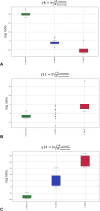The dysbiosis of ovine foot microbiome during the development and treatment of contagious ovine digital dermatitis
- PMID: 33597028
- PMCID: PMC7888161
- DOI: 10.1186/s42523-021-00078-4
The dysbiosis of ovine foot microbiome during the development and treatment of contagious ovine digital dermatitis
Abstract
Background: Contagious Ovine Digital Dermatitis (CODD) is an emerging and common infectious foot disease of sheep which causes severe welfare and economic problems for the sheep industry. The aetiology of the disease is not fully understood and control of the disease is problematic. The aim of this study was to investigate the polybacterial aetiopathogenesis of CODD and the effects of antibiotic treatment, in a longitudinal study of an experimentally induced disease outbreak using a 16S rRNA gene amplicon sequencing approach.
Results: CODD was induced in 15/30 experimental sheep. During the development of CODD three distinct phenotypic lesion stages were observed. These were an initial interdigital dermatitis (ID) lesion, followed by a footrot (FR) lesion, then finally a CODD lesion. Distinct microbiota were observed for each lesion in terms of microbial diversity, clustering and composition. Porphyromonadaceae, Family XI, Veillonellaceae and Fusobacteriaceae were significantly associated with the diseased feet. Veillonellaceae and Fusobacteriaceae were most associated with the earlier stages of ID and footrot rather than CODD. Following antibiotic treatment of the sheep, the foot microbiota showed a strong tendency to return to the composition of the healthy state. The microbiota composition of CODD lesions collected by swab and biopsy methods were different. In particular, the Spirochaetaceae family were more abundant in samples collected by the biopsy method, suggesting that these bacteria are present in deeper tissues of the diseased foot.
Conclusion: In this study, CODD presented as part of a spectrum of poly-bacterial foot disease strongly associated with bacterial families Porphyromonadaceae, Family XI (a family in Clostridiales also known as Clostridium cluster XI), Veillonellaceae and Fusobacteriaceae which are predominately Gram-negative anaerobes. Following antibiotic treatment, the microbiome showed a strong tendency to return to the composition of the healthy state. The composition of the healthy foot microbiome does not influence susceptibility to CODD. Based on the data presented here and that CODD appears to be the severest end stage of sheep infectious foot disease lesions, better control of the initial ID and FR lesions would enable better control of CODD and enable better animal welfare.
Keywords: CODD; Footrot; Lameness; Microbiome; Sheep.
Conflict of interest statement
The authors declare that they have no competing interests.
Figures














References
-
- Harwood DG, Cattell JH, Lewis CJ, Naylor R. Virulent footrot in sheep. Vet Rec Lett. 1997;140(26):687. - PubMed
-
- Dickins A, Clark CCA, Kaler J, Ferguson E, O’Kane H, Green LE. Factors associated with the presence and prevalence of contagious ovine digital dermatitis: a 2013 study of 1136 random English sheep flocks. Prev Vet Med. 2016;130:86–93. - PubMed
-
- Angell JW, Duncan JS, Carter SD, Grove-White DH. Farmer reported prevalence and factors associated with contagious ovine digital dermatitis in Wales: a questionnaire of 511 sheep farmers. Prev Vet Med. 2014;113(1):132–138. - PubMed
Grants and funding
LinkOut - more resources
Full Text Sources
Other Literature Sources
